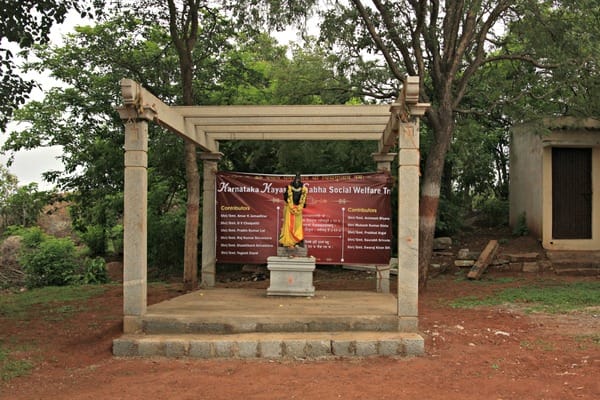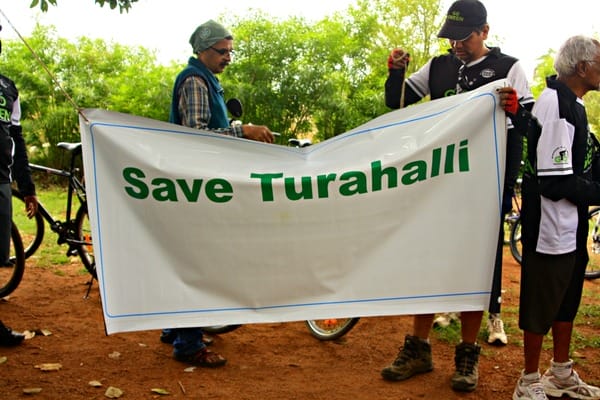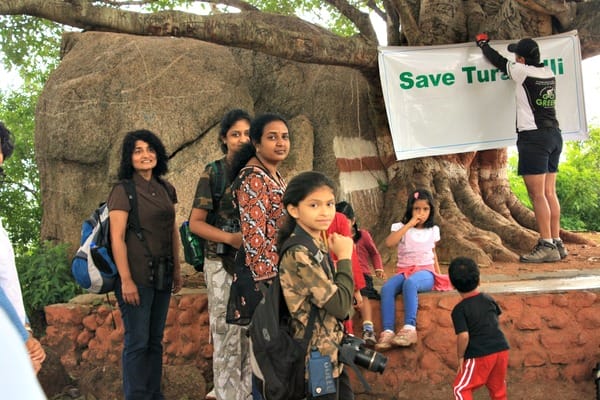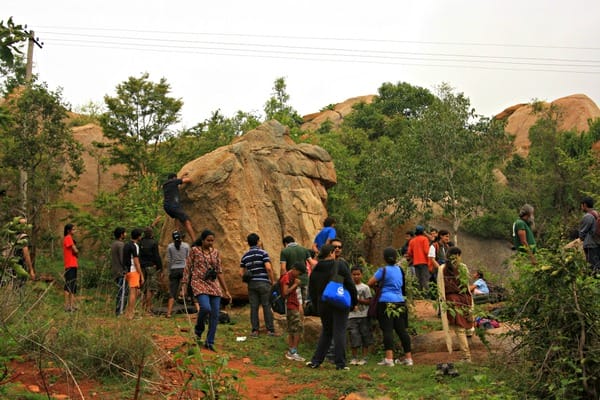Recently BBMP, decided that it would put up an “adventure sports hub” on the hillocks of Turahalli forest on Kanakapura road. Nature lovers who regularly trek to the forest decided it was time to protest.
Old-timers of Bangalore will recollect Turahalli as a lovely forest, set with hillocks, where everyone could go, and did.
Over a period of years, the pressure of population in Bangalore has meant that the once pristine forest has been “developed” into various layouts. All that remains is just a couple of hillocks. These are beloved to nature lovers, cyclists who organise downhill runs here, rock-climbers for whom the crags of the hillock are very inviting.
This is of course apart from the residents around the forest – the shepherds and the cowherds. Several devotees also visit the two temples on the hillocks, even these temples are being “developed” in an illegal way.

Illegal new shrine at Turahalli. Pic: Deepa Mohan
Leo Saldanha of Environment Support Group, who has always stood against the privatisation of public commons, sent out an email calling for some action. His email underscored the fact that once again, public property was likely to be privatised and earmarked only for the use of the more wealthy sections of society. And be restricted to all the people who were enjoying it earlier. Here’s an excerpt from the email that Leo sent out to concerned citizens:
“Unfortunately, the Karnataka Forest Department is keen on developing a variety of high end and elite oriented tourism infrastructure which is certain to spoil the grandeur of this forest, could well be an illegal development and may potentially end up commodifying this forest.
Last Sunday, there was a very big function to expand one of the two temples that have illegally come up inside the forest. Locals report that this had the tacit approval (and possible involvement) of senior forest officials. A complaint has been lodged and this matter is being investigated.”
Deepak Arya, one of the avid and experienced birders of Bangalore, and his friend Venkatesh M, decided to have a “Turahalli Festival”, to highlight the fact that many diverse people were enjoying the common space, and would not like it to be privatised. The Turahalli Habba was announced on Facebook, and other social networking sites,and word was also spread through email and the media, to some extent.

Deepak Arya helps to put up the banner. Pic: Deepa Mohan
Our group, consisting of nature-lovers and bird watchers, reached Turahalli hillock quite early, as the birds get disturbed once a lot of people arrive on the scene. We climbed up the outcrops and reached one of the temples.
A few other people like the group of cyclists and members of “Go Green,” an initiative started by Prabhakar Rao also joined.
A banner, saying, “Save Turahalli” was put up on the massive Ficus tree in front of the temple, and several visitors signed it. Leo Saldanha spoke about the past (the free access to forests and public spaces) , the present (encroachment and “development”) and the future (the need to keep public commons accessible to all).
Deepak Arya spoke of the way the hillocks were being encroached by construction on all sides, and the need to save the last large lung space in south Bangalore.

Concerned citizens. Pic: Deepa Mohan
K Umashankar, the Chief Instructor of General Thimayya National Academy of Adventure was present, as were noted tree-experts, Sheshadri Ramaswamy and Prashanth Iyengar. They were there to conduct a tree census in the area.
A simple vegetarian lunch was served to everyone present; the caterers did not use plastic cups for water, and served the food in steel plates. All litter was collected and taken back. Deepak had requested the caterers to deliver the leftover food to an orphanage.
For a long time afterwards, the rock-climbers were having a field day, as there were experts on hand to give the newbies a try at the activity. Many children were seen trying it out, under the watchful eyes of their parents.

Rock climbers. Pic: Deepa Mohan
Those who attended the festival got all whimsical and nostalgic about the forest. Chandra Ravikumar, a concerned citizen of Bangalore,said “The rocks, the trees, the little spaces between the stones, the little white-streaked straggling vines gripping the slopes, the rare white star of the kadu mallige (wild variety of jasmine), the easy breathing and expanding lungs, the scent of something green – if this lingering beauty is just a leftover morsel, how beautiful my Bangalore must have been fifty years ago!”
The road up to the Shaneeshwara temple is now motorable, making it vulnerable to tourists driving up in cars, littering and disturbing the peace. Arya adds, “I am hearing reports of dirt bikes zooming up the road, and of drinking parties on these rocks. These are matters that concern us, as citizens, and we must keep a vigilant eye out.” For Leo, it is a simple principle that is being compromised: the public commons are under threat of being privatised.
“Turahalli is the last remaining wilderness space so close to South Bangalore. Everyone in the adventure community, be it climbers, walkers, birdwatchers or cyclists, have a responsibility to keep the forests as they are, and leave minimum impact. The same responsibility does not seem to hold good with temple constructions and the like,” adds Venkatesh, alias Venky.
Let us hope that this public space and little parcel of forest is spared for us and our succeeding generations, and does not get swallowed up in the name of adventure sports or “development!”⊕
Very heartening results of the Turahalli Habba: see Leo’s report, on my CM blog:
http://bangalore.citizenmatters.in/blogs/show_entry/4524
A big thank you to every one of you who put in so much of effort. We need to continuously monitor this last piece of wilderness.
I was considering to buy a Sobha property close to this place and would not like to award them if due diligence was not followed.